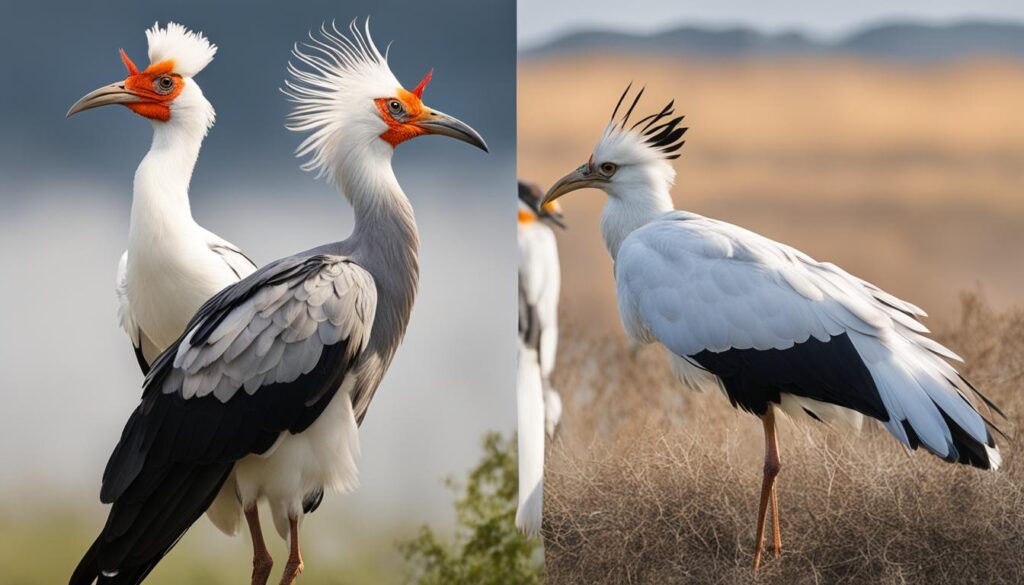The secretary bird (Sagittarius serpentarius) and the stork are both large birds, but they have distinct differences in their physical characteristics, habitats, and behaviors. While the secretary bird is a bird of prey belonging to the Accipitriformes order, the stork is part of the Ciconiiformes order. This article will delve into the unique features and traits of each species, allowing for a comprehensive understanding of the difference between secretary birds and storks.
Key Takeaways:
- The secretary bird and the stork belong to different bird orders: Accipitriformes and Ciconiiformes, respectively.
- Secretary birds have tall and slender bodies, while storks have a more stork-like appearance with long necks and legs.
- Secretary birds primarily hunt on foot, using their long legs and strong kicks, while storks are piscivorous, feeding on fish and other aquatic prey.
- Secretary birds prefer open grasslands and savannahs as their habitat, while storks inhabit wetland habitats such as marshes and coastal areas.
- Secretary birds and storks have different reproductive habits, with secretary birds laying one to three eggs and storks laying three to five eggs.
Physical Characteristics
The physical characteristics of secretary birds and storks distinguish them from each other. Secretary birds are easily recognizable due to their tall and slender bodies, long legs, and black and white plumage. They have a distinctive crest of black feathers on their heads, orange faces with long lashes, and wings with black flight feathers. Moreover, secretary birds have a wingspan of approximately 6.2 feet (1.9 meters), adding to their impressive appearance. On the other hand, storks have a more stork-like appearance with their predominantly grey plumage, long legs, and long necks. They have a prominent bill that is long and slightly curved, enabling them to efficiently catch fish and other prey. Storks also have a wingspan ranging from 5.2 to 7.5 feet (1.6 to 2.3 meters).
In terms of size, secretary birds are generally taller than storks. Adult secretary birds stand at an average height of 4.3 to 4.9 feet (1.3 to 1.5 meters), while storks have an average height of 2.6 to 3.9 feet (0.8 to 1.2 meters). These physical differences reflect the unique adaptations and evolutionary paths that secretary birds and storks have undergone.
Plumage and Crest Comparison
Table: Comparison of Plumage and Crest Characteristics
| Species | Plumage | Crest |
|---|---|---|
| Secretary Bird | Black and white plumage | Distinctive crest of black feathers on the head |
| Stork | Predominantly grey plumage | No crest |
Table: Comparison of Plumage and Crest Characteristics
The table above highlights the differences in plumage and crest between secretary birds and storks. While secretary birds possess black and white plumage with a distinctive crest, storks have predominantly grey plumage with no crest. These unique physical characteristics contribute to the visual identification and differentiation of these two bird species.
Habitat
The habitat preferences of secretary birds and storks differ due to their distinct ecological needs. Secretary birds are typically found in open grasslands and savannahs throughout sub-Saharan Africa. These birds prefer areas with low vegetation, as it allows them to have a clear line of sight to spot their prey. Their specialized hunting behavior, which involves hunting on foot, requires suitable open habitats where they can efficiently move and capture their prey.
On the other hand, storks inhabit various wetland habitats, including marshes, rivers, lakes, and coastal areas. These areas provide abundant food sources for storks, particularly fish and other aquatic prey. Storks often build their nests near bodies of water, where they can access their food easily. They may also choose to nest in tall trees or cliffs, depending on the species and availability of suitable nesting sites.
| Secretary Birds | Storks |
|---|---|
| Open grasslands and savannahs | Wetland habitats |
| Prefer low vegetation | Proximity to water sources |
| Suitable for hunting on foot | Abundant aquatic prey |
These distinct habitat preferences reflect the specific adaptations and ecological roles of secretary birds and storks. While secretary birds excel in hunting in open grasslands, storks have evolved to thrive in wetland environments where they can access an abundant supply of aquatic prey.
Behavior
The behavior of secretary birds and storks showcases their unique adaptations and hunting strategies. Secretary birds are known for their distinctive hunting behavior, primarily relying on their strong legs and sharp talons. They hunt on foot, stomping on their prey with remarkable force. Secretary birds are particularly skilled at capturing snakes, using their powerful kicks to immobilize and kill them. They also feed on lizards, small mammals, and insects. With their exceptional eyesight, they can spot their prey from great distances, allowing them to efficiently track and capture their targets.
Storks, on the other hand, have a different feeding preference. They are primarily piscivorous, meaning they primarily feed on fish. Storks have long, sharp beaks that they use to catch their prey, swiftly striking and swallowing fish whole. While fish make up the majority of their diet, storks also consume other aquatic prey such as frogs, small reptiles, and crustaceans. Their long legs and wingspan enable them to wade through shallow water and navigate wetland habitats with ease, ensuring a plentiful food supply.
The hunting behavior of secretary birds and storks exemplifies their remarkable adaptations and demonstrates their effectiveness as predators.
Hunting Techniques
Secretary Bird
- Hunts on foot, using strong kicks to capture prey
- Skilled at capturing snakes and lizards
- Exceptional eyesight for spotting prey from a distance
Stork
- Piscivorous, primarily feeds on fish
- Uses sharp beak to catch and swallow prey
- Also consumes frogs, small reptiles, and crustaceans
The distinct hunting techniques of secretary birds and storks highlight their specialization and unique ecological roles within their respective habitats. While secretary birds are agile predators on land, storks have adapted to thrive in watery environments, demonstrating their versatility and adaptability as hunters.
Reproduction and Nesting
Secretary birds and storks have distinct differences in their reproductive habits. Secretary birds typically form monogamous pairs and build large nests in trees or on the ground. They lay one to three eggs, which are mainly incubated by the female, with the male also participating in the incubation process. This shared responsibility ensures the success of the hatchlings. The incubation period lasts for approximately 45 days, after which the chicks hatch and are cared for by both parents.
Storks, on the other hand, also form monogamous pairs and build large nests, but their reproductive process differs from that of secretary birds. Instead of laying a few eggs, storks lay one clutch of three to five eggs. Both parents take turns incubating the eggs, ensuring their proper development. The incubation period for stork eggs can vary depending on the species, ranging from 30 to 40 days. Once the eggs hatch, the parents diligently provide food and protection to the chicks until they are ready to fledge.
It is fascinating to observe the dedication and cooperation exhibited by both secretary birds and storks during the nesting and reproductive period. Their commitment to raising their offspring underscores the importance of parental care in the avian world.
Comparison of Secretary Bird and Stork Nesting Habits
| Species | Nesting Location | Number of Eggs | Incubation Period | Parental Care |
|---|---|---|---|---|
| Secretary Bird | Trees or Ground | 1 to 3 | Approximately 45 days | Shared responsibility between male and female |
| Stork | Tall trees, cliffs, or man-made structures | 1 clutch of 3 to 5 | 30 to 40 days | Both parents take turns incubating |
Table: A comparison of the nesting habits of secretary birds and storks.
Conservation Status
The conservation status of the secretary bird (Sagittarius serpentarius) and storks varies, with the former being classified as vulnerable by the IUCN Red List. This iconic bird of prey faces several threats, including habitat degradation, hunting, and capture for the trade. The loss and fragmentation of its natural grassland and savannah habitats pose a significant risk to its long-term survival.
Efforts are underway to raise awareness about the conservation needs of the secretary bird and implement measures to protect this unique species. Collaborative initiatives involving local communities, conservation organizations, and governments aim to address the threats it faces and ensure its continued presence in African ecosystems.
“The secretary bird’s vulnerability highlights the importance of preserving its habitat and raising awareness about its conservation needs. By safeguarding its grassland and savannah ecosystems, we can ensure the continued existence of this magnificent bird.”
Storks, on the other hand, have varying conservation statuses depending on the species. While some stork species, such as the Marabou stork, are currently listed as least concern, others, like the Greater Adjutant, face a bleak future as they are considered critically endangered. Habitat loss, pollution, and hunting are some of the main threats contributing to the decline of these stork species.
Conservation efforts for storks focus on preserving their wetland habitats, raising awareness about their ecological importance, and implementing measures to mitigate threats such as habitat degradation and illegal hunting. International collaborations and local initiatives play a crucial role in safeguarding these birds and ensuring their survival for future generations.

Comparison of Conservation Status
| Species | Conservation Status |
|---|---|
| Secretary Bird | Vulnerable |
| Marabou Stork | Least Concern |
| Greater Adjutant | Critically Endangered |
Conclusion
In conclusion, the difference between secretary birds and storks lies in their physical characteristics, habitats, and reproductive habits. While both species are large birds, secretary birds have tall and slender bodies with black and white plumage, while storks have predominantly grey plumage with long necks and bills. Secretary birds prefer open grasslands and savannahs, whereas storks inhabit various wetland habitats.
Furthermore, secretary birds exhibit unique hunting behavior, primarily on foot, using their long legs and strong kicks to capture prey. Storks, on the other hand, are known for their piscivorous habits, relying on their sharp beaks to catch and swallow fish and other aquatic prey. Additionally, the reproductive habits of these birds differ, with secretary birds laying one to three eggs and storks laying three to five eggs in a clutch.
While secretary birds face the threat of habitat degradation and hunting, storks have varying conservation statuses, with some species listed as least concern and others as critically endangered. Understanding the Secretary Bird Stork differences allows us to appreciate the unique adaptations and ecological roles of both species in their respective environments.
FAQ
What are the physical characteristics of secretary birds and storks?
Secretary birds have tall and slender bodies, long legs, black and white plumage, a crest of black feathers on their heads, and orange faces. Storks have predominantly grey plumage, long legs, long necks, and a prominent bill that is long and slightly curved.
What habitats do secretary birds and storks prefer?
Secretary birds are typically found in open grasslands and savannahs, while storks inhabit various wetland habitats such as marshes, rivers, lakes, and coastal areas.
What are the hunting behaviors of secretary birds and storks?
Secretary birds primarily hunt on foot, using their long legs and strong kicks to capture prey like snakes, lizards, and small mammals. Storks are primarily piscivorous, feeding on fish and other aquatic prey, which they catch with their sharp beaks.
How do secretary birds and storks reproduce?
Secretary birds form monogamous pairs, build large nests, and lay one to three eggs. The female mainly incubates the eggs, while the male also participates in the process. Storks also form monogamous pairs, build large nests, lay one clutch of three to five eggs, and both parents incubate the eggs.
What is the conservation status of secretary birds and storks?
Secretary birds are classified as vulnerable, primarily due to habitat degradation, hunting, and capture for the trade. Storks have varying conservation statuses, with some species listed as least concern and others considered critically endangered.
 Skip to main content
Skip to main content


